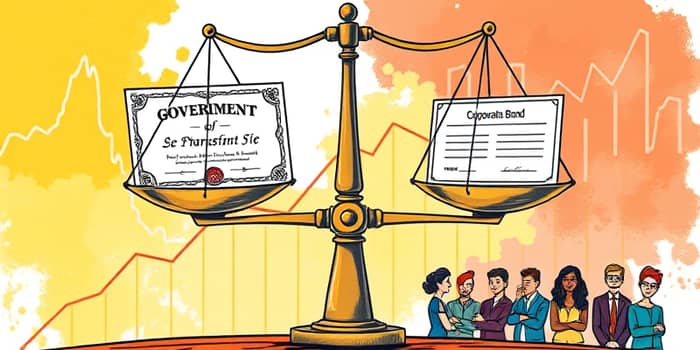
In a world where financial stability often feels like a distant shore, bonds stand out as beacons of predictability and peace of mind. Investors seeking a refuge from relentless market volatility can turn to fixed-income instruments to anchor their portfolios and chart a calmer course.
Whether you’re beginning your journey or refining a seasoned strategy, understanding the nuanced differences between government-issued Treasury bonds and privately issued corporate bonds is vital. This comparison will empower you with both vision and practical steps to build a resilient bond allocation.
Treasury bonds, often called government bonds, are debt instruments issued by the U.S. Department of the Treasury to finance public spending. Corporate bonds represent loans from investors to companies, used for expansion, refinancing, or operational needs.
At first glance, both promise regular interest payments and return of principal at maturity. Yet behind this similarity lies a tapestry of distinctions in creditworthiness, yield potential, and market dynamics.
Default risk is the most critical differentiator. Treasuries carry a virtually risk-free in U.S. standing, backed by the government’s ability to print currency and honor obligations under any economic climate.
Corporate bonds, however, expose investors to the ebb and flow of individual companies. Credit ratings from AAA to junk status gauge the likelihood of timely payments, and economic downturns can stress even high-grade issuers.
Market risk further amplifies these differences: when equities tumble, Treasury prices often rise as safe-haven demand surges. Corporate issues, in contrast, can suffer significant price declines in downturns, reflecting wider credit spreads and investor caution.
Higher risk typically begets higher reward. Corporate bonds generally offer higher yields to compensate for risk compared to Treasuries of equivalent maturity. For instance, if a 10-year Treasury yields 4.5%, an investment-grade corporate bond might yield between 5.5% and 7%.
This differential is known as the credit spread. During calm markets, spreads narrow as investors chase incremental yield. In times of stress, spreads widen, sometimes dramatically, as perceived default probabilities rise.
No matter how attractive a yield, an inability to trade quickly can erode returns. Treasuries boast deep, transparent markets, making them extremely liquid at almost any time.
Corporate bonds are generally liquid if issued by large firms, yet smaller or lower-rated issues may carry wider bid/ask spreads and trading costs. That can affect both entry and exit prices for individual investors.
Tax treatment also diverges. Treasury interest is exempt from state and local taxes, though fully taxable at the federal level. Corporate bond interest faces taxation at every tier—federal, state, and sometimes local.
Your personal goals and risk tolerance should guide the balance between safety and yield. Treasuries often serve as the essential anchor for conservative portfolios, especially for retirees or those seeking capital preservation.
Corporate bonds appeal to growth-oriented investors by offering enhanced returns. However, diligent credit analysis—assessing covenants, seniority, and call provisions—is a vital tool for credit analysis and risk management.
Benchmarks such as the Bloomberg U.S. Aggregate Bond Index and the Bloomberg U.S. Corporate Bond Index track broad Treasury and corporate markets respectively. They reveal how each bond category performs under varying economic conditions.
During the 2008–09 financial crisis and the 2020 COVID downturn, Treasuries preserved value while corporates experienced drawdowns. In contrast, during stable or expanding economies, corporate bonds often outperformed, underscoring the reflect the risk–reward trade-off inherent in fixed income.
With a clear understanding of fundamentals, risks, yields, and taxes, you can craft a bond strategy that aligns with your financial vision. Begin by defining your allocation targets, considering both the income you need and the losses you can tolerate in stressed markets.
Diversification across maturities and credit qualities can smooth returns and shield your portfolio from sudden shocks. Regularly rebalance to maintain your desired mix, and stay vigilant to economic indicators that may shift rates and spreads.
In the end, bonds are more than just fixed-income securities; they are tools to shape your financial future. By comparing Treasuries and corporate bonds with both heart and mind, you can build a resilient foundation and pursue your goals with confidence.
Embrace the clarity of informed decisions and let the balanced blend of government and corporate bonds guide you toward steady growth and lasting peace of mind.
References













